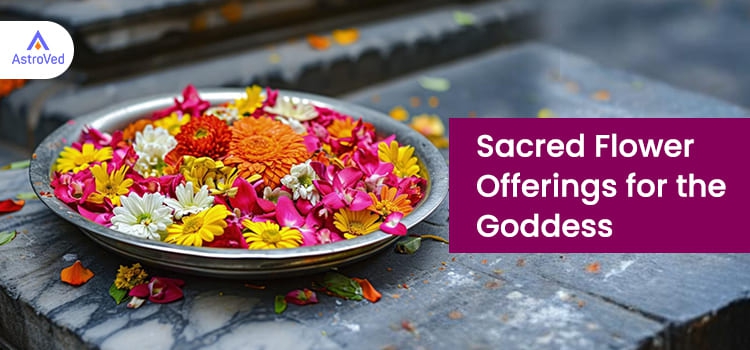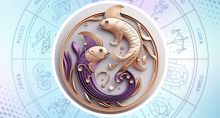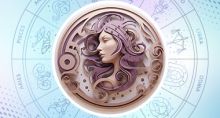Sacred Flower Offerings for the Goddess
In Hindu worship, flowers have an important place as they symbolize many things like devotion, purity, power, energy, etc. People make offerings of flowers to gods and goddesses to please them. The deities even have their favorite flowers, which are a must during Poojas and other rituals. Their absence may render the ritual incomplete. In the word ‘Pooja’, ‘Poo’ means flower.
Each deity has an association with a particular flower in Hinduism. According to religious texts, there is an entire science of vibrations and waves underlying this. Deities have their own frequencies. Different colors and fragrances give different qualities and frequencies to each flower. Due to this, they tend to attract different principles of deities. On receiving these frequencies, the deities return them to the atmosphere as vibrations through the flowers. This is called “pavitrak”.
Put simply, there are specific energy patterns, colors, and fragrances that resonate with each deity. Flowers are the medium through which these characteristics are met, and through them, the divine exchange of energy from the god to the devotee takes place.

Hence, people see flowers as a manifestation of ‘Astha’ or their devotional emotion. It’s why flower offerings are a must during Poojas. They are essential to invoke the deity’s blessings.
In this article, we shall learn about the flower offerings for the Goddess, especially during Durga Pooja.
Durga Pooja is a major Hindu festival in India. It is a 10-day celebration that honors 9 forms of Shakti, the Divine Mother. On each day of the festival, devotees worship the Goddess with different flowers and Bhog.
Here are the sacred flower offerings to the Goddess.
Hibiscus
Hindi Name: Gudahal or Udhul
Botanical Name: Hibiscus rosa-Sinensis
Hibiscus is one of the main flowers during Durga Pooja, as it is a favorite of the Goddess. Scriptures speak of the goddess’ fondness for this flower, which she loves the most. On Day 1 of Navratri, devotees worship Durga as Shailputri. The Hibiscus flower is the favored offering for this form of Parvati.
Chrysanthemum
Hindi Name: Sevanti
Botanical Name: Chrysanthemum X morifolium
On Day 2 of Durga Pooja, people honor the Brahmacharini form of Durga. This form embodies love, loyalty, wisdom, and knowledge. Dressed in white clothes, she has a Japamala in her right hand and a Kamandalu in her left.
Lotus
Hindi Name: Kamal
Botanical Name: Nelumbo nucifera
Goddess Chandraghanta is the object of worship on Day 3 of the festival. The Goddess has 3 eyes, of which one is always open, showing that she is ready to fight evil at all times. Lotus flowers are used in her worship.
Crepe Jasmine
Hindi Name: Chandani
Botanical Name: Tabernaemontana divaricata
On Day 4 of Navratri, the object of worship is Goddess Kushmanda, who has the power to eliminate darkness from one’s life. Crepe Jasmine flowers are an essential part of the Pooja, as well as sweets like Malpua.
Rose
Hindi name: Gulaab
Botanical Name: Rosa Indica
Durga loves all red flowers. As she is the embodiment of courage, which is symbolized by the color red, it is not surprising. Hence, offerings made to her, be it a flower, fruit, or garment, are red-colored. People worship the Skandamata form of Durga on Day 5. Red and yellow flowers are the main offerings on this day.
Marigold
Hindi name: Genda
Botanical Name: Tagetes
Goddess Lakshmi, the consort of Vishnu, is also a form of Durga. Yellow flowers like Marigold are dear to her. On Day 6 of Navratri, Katyayani Devi, a form of Durga, is worshipped. She is a very fierce form. Marigold flowers and Honey as bhog are the main offerings to her.
Passionflower
Hindi Name: Krishna Kamal
Botanical Name: Passiflora
People worship Goddess Kaalratri on Day 7 of Navratri. She is a manifestation of Goddess Kali, who destroys evil, demons, and negative energies. She is one of the most ferocious forms of Durga. Krishna Kamal or Passionflower is her favorite flower. People also offer her jaggery on this day.
Arabian Jasmine
Hindi name: Mogra
Botanical Name: Jasminum samba
Arabian Jasmine or Mogra has a very nice and strong fragrance. On Day 8 of Navratri, the Mahagauri form of Parvati is worshipped with these flowers and coconut. The Goddess bestows progeny, peace, and tranquility.
White Frangipani
Hindi Name: Champa
Botanical name: Plumeria Alba
Goddess Siddhidhatri is the object of worship on Day 9 of Navratri. Her favorite flower is the white Frangipani or Champa. The Goddess bestows wisdom, power, and intellect.
Butterfly Pea
Hindi name: Aparajita / Shankhpushpi
Botanical Name: Clitoria ternatea
Did you know that Aparajita (meaning ‘the unvanquished’) is another name for Goddess Durga? Little wonder, then, that this flower is one of her favorite sacred flowers. It is also dear to Shiva and Parvati.
Red Oleander
Hindi Name: Laal Kaner
Botanical Name: Nerium Alexander
Red Oleander is commonly used in different types of worship. It is integral to the worship of Durga, Kali, and Parvati. It is also used in Tantra sadhana.
Butea Gum
Hindi Name: Palash Flower
Botanical Name: Butea monosperma
The Palash tree and flower are very sacred in Hinduism. The flowers have many medicinal properties and are used in the worship of Durga and Saraswati.




















